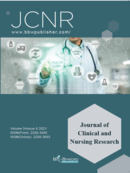Advance in Nutritional Status and Intervention after Spinal Cord Injury
Abstract
Spinal cord injury (SCI) is a common disease in spinal surgery. SCI affects the metabolism of patients and changes their lifestyle. Nutritional problems may occur, which may be manifested as insufficient or overnutrition. Nutrition status is related to many complications and final outcome after SCI. In this paper, the nutritional status of patients with SCI and the progress of nutritional intervention were reviewed by comprehensive domestic and foreign literature. Medical staff should routinely screen and evaluate the nutrition of patients after SCI operation, and provide comprehensive nutritional intervention such as diet, exercise and dietary supplement.
References
Rouanet C, Reges D, Rocha A, et al., 2017, Traumatic Spinal Cord Injury: Current Concepts and Treatment Update. Arquivos de Neuro-Psiquiatria, 75(6): 387-393.
Hamid R, Averbeck MA, Chiang H, et al., 2018, Epidemiology and Pathophysiology of Neurogenic Bladder After Spinal Cord Injury. World Journal of Urology, 36(10): 1517-1527.
Tafida MA, Wagatsuma Y, Ma E, et al., 2018, Descriptive Epidemiology of Traumatic Spinal Injury in Japan. Journal of Orthopaedic Science, 23(2): 273-276.
Chen X, Chen D, Chen C, et al., 2018, Systematic Evaluation of Epidemiology and Disease Burden of Traumatic Spinal Cord Injury in China[J]. Chinese Journal of Evidence-Based Medicine, 18(2): 143-150.
Wang Y, Ma K, Wu Y, et al., 2016, Nutritional Problems and Intervention in Patients with Chronic Spinal Cord Injury. Chinese Journal of Rehabilitation Theory and Practice, 22(1): 69-71.
Chen X, Liu Z, Sun T, et al., 2013, Relationship between Nutritional Status and Mortality in Patients with Cervical Spinal Cord Injury. Chinese Journal of Bone and Joint Injury, 28(3): 204-206.
Wong S, Derry F, Jamous A, et al., 2014, Is Undernutrition Risk Associated with an Adverse Clinical Outcome in Spinal Cord Injured Patients Admitted to a Spinal Centre? European Journal of Clinical Nutrition, 68(1): 125-130.
Zhou J, Chen W, Hu R, et al., 2017, Comparison of Application on Nutritional Screening Scale for Spinal Cord Injury and General Screening Scale for Malnutrition in Early Rehabilitation of Patients with Spinal Cord Injury. Chinese Journal of Spine and Spinal Cord, 27 (9): 829-831.
Eser P, Frotzler A, Zehnder Y, et al., 2005, Assessment of Anthropometric Systemic and Lifestyle Factors Influencing Bone Status in the Legs of Spinal Cord Injured Individuals. Osteoporosis International, 16(1): 26-34.
Panisset MG, Galea MP, El-Ansary D, 2016, Does Early Exercise Attenuate Muscle Atrophy or Bone Loss After Spinal Cord Injury? Spinal Cord, 54(2): 84-92.
Pellicane AJ, Millis SR, Zimmerman SE, et al., 2013, Calorie and Protein Intake in Acute Rehabilitation Inpatients with Traumatic Spinal Cord Injury Versus Other Diagnoses. Topics Spinal Cord Injury Rehabilitation, 19(3): 229-235.
Wong S, Kenssous N, Hillier C, et al., 2018, Detecting Malnutrition Risk and Obesity After Spinal Cord Injury: A Quality Improvement Project and Systematic Review. European Journal of Clinical Nutrition, 72(11): 1555-1560.
Gater DR. Jr., 2007, Obesity After Spinal Cord Injury. Physical Medicine and Rehabilitation Clinics of North America, 18(2): 333-351.
Gorgey AS, Dolbow DR, Dolbow JD, et al., 2014, Effects of Spinal Cord Injury on Body Composition and Metabolic Profile-Part I. Journal of Spinal Cord Medicine, 37(6): 693-702.
Maruyama Y, Mizuguchi M, Yaginuma T, et al., 2008, Serum Leptin Abdominal Obesity and the Metabolic Syndrome in Individuals with Chronic Spinal Cord Injury. Spinal Cord, 46(7): 494-499.
Mollinger LA, Spurr GB, Chatt AZ, et al., 1985, Daily Energy Expenditure and Basal Metabolic Rates of Patients with Spinal Cord Injury. Archives of Physical Medicine and Rehabilitation, 66(7): 420-426.
Monroe MB, Tataranni PA, Pratley R, et al., 1998, Lower Daily Energy Expenditure as Measured by a Respiratory Chamber in Subjects with Spinal Cord Injury Compared with Control Subjects. American Journal of Clinical Nutrition, 68(6): 1223-1227.
Perret C, Stoffel-Kurtb N, 2011, Comparison of Nutritional Intake between Individuals with Acute and Chronic Spinal Cord Injury. Journal of Spinal Cord Medicine, 34(6): 569-575.
Gorgey AS, Mather KJ, Gater DR, 2011, Central Adiposity Associations to Carbohydrate and Lipid Metabolism in Individuals with Complete Motor Spinal Cord Injury. Metabolism, 60(6): 843-851.
Khalil RE, Gorgey AS, Janisko M, et al., 2013, The Role of Nutrition in Health Status After Spinal Cord Injury. Aging and Disease, 4(1): 14-22.
Tomey KM, Chen DM, Wang X, et al., 2005, Dietary Intake and Nutritional Status of Urban Community-Dwelling Men with Paraplegia. Archives of Physical Medicine and Rehabilitation, 86(4): 664-671.
Groah SL, Nash MS, Ljungberg IH, et al., 2009, Nutrient Intake and Body Habitus After Spinal Cord Injury: An Analysis by Sex and Level of Injury. Journal of Spinal Cord Medicine, 32(1): 25 -33.
Wong S, Derry F, Jamous A, et al., 2012, The Prevalence of Malnutrition in Spinal Cord Injuries Patients: A UK Multicentre Study. British Journal of Nutrition, 108(5): 918-923.
Chen X, Liu Z, Sun T, et al., 2014, Relationship between Nutritional Status and Mortality during the First 2 Weeks Following Treatment for Cervical Spinal Cord Injury. Journal of Spinal Cord Medicine, 37(1): 72-78.
Kaufman HH, Rowlands BJ, Stein DK, et al., 1985, General Metabolism in Patients with Acute Paraplegia and Quadriplegia. Neurosurgery, 6(3): 309-313.
Jin GX, Li L, Cui SQ, et al., 2014, Persistent Hypoalbuminemia is a Predictor of Outcome in Cervical Spinal Cord Injury. The Spine Journal, 14(9): 1902-1908.
Chen Y, Shao J, Zhu W, et al., 2013, Identification of Risk Factors for Respiratory Complications in Upper Cervical Spinal Injured Patients with Neurological Impairment. Acta Orthopaedica et Traumatologica Turcica, 47(2): 111-117.
Luan B, Li X, Xu K, et al., 2015, Analysis of Characteristics and Related Factors of Nosocomial Infection in Patients with Spinal Cord Injury during Convalescence. Chinese Journal of Nosocomiology, 25 (17): 4009-4011
Mao R, Jiang J, Peng H., 2010, Risk Factors for Urinary Tract Infection in Patients with Spinal Injury during Convalescence. Chinese Journal of Rehabilitation Medicine, 25(10): 957-962.
Frisbie JH, 2010, Anemia and Hypoalbuminemia of Chronic Spinal Cord Injury: Prevalence and Prognostic Significance. Spinal Cord, 48(7): 566-569.
Pelletier CA, Miyatani M, Giangregorio L, et al., 2016, Sarcopenic Obesity in Adults with Spinal Cord Injury: A Cross-Sectional Study. Archives of Physical Medicine and Rehabilitation, 97(11): 1931-1937.
Emmons RR, Garber CE, Cirnigliaro CM, et al., 2010, The Influence of Visceral Fat on the Postprandial Lipemic Response in Men with Paraplegia. Journal of the American College of Nutrition, 29(5): 476-481.
Bigford G, Nash MS, 2017, Nutritional Health Considerations for Persons with Spinal Cord Injury. Topics in Spinal Cord Injury Rehabilitation, 23(3): 188-206.
Nash MS, Bilzon JLJ, 2018, Guideline Approaches for Cardioendocrine Disease Surveillance and Treatment Following Spinal Cord Injury. Current Physical Medicine and Rehabilitation Reports, 6(4): 264-276.
Farkas GJ, Gater DR, 2018, Neurogenic Obesity and Systemic Inflammation Following Spinal Cord Injury: A Review. Journal of Spinal Cord Medicine, 41(4): 378-387.
Wong S, Derry F, Jamous A, et al., 2012, A Validation of the Spinal Nutrition Screening Tool (SNST) in Patients with Spinal Cord Injuries (SCI): Result from a Multicentre Study. European Journal of Clinical Nutrition, 66(3): 382-387.
Shin JC, Chang SH, Hwang SW, et al., 2018, The Nutritional Status and The Clinical Outcomes of Patients with a Spinal Cord Injury Using Nutritional Screening Tools. Annals of Rehabilitation Medicine-arm, 42(4): 591-600.
Yarar-Fisher C, Chen Y, Jackson AB, et al., 2013, Body Mass Index Underestimates Adiposity in Women with Spinal Cord Injury. Obesity (Silver Spring), 21(6): 1223-1225.
Yang Y, Li Y, Fu J, et al., 2018, Development Status of Skin Fold Thickness and Body Composition of Daur Children and Teenagers and Its Changes in the Past 16 Years. Journal of Inner Mongolia Normal University (Natural Science Edition), 47 (6): 499-504.
Frankenfield D, 2006, Energy Expenditure and Protein Requirements after Traumatic Injury. Nutrition in Clinical Practice, 21(5): 430-437.
Wilt TJ, Carlson KF, Goldish GD, et al., 2008, Carbohydrate and Lipid Disorders and Relevant Considerations in Persons with Spinal Cord Injury. Evidence Report / Technology Assessment, 63(163) : 1-95.
Saris WHM, Astrup A, Prentice AM, et al., 2000, Randomized Controlled Trial of Changes in Dietary Carbohydrate / Fat Ratio and Simple Vs Complex Carbohydrates on Body Weight and Blood Lipids: The CARMEN Study. International Journal of Obesity and Related Metabolic Disorders, 24(10): 1310-1318.
Tsunoda N, Inayama T, Hata K, et al., 2015, Vegetable Dishes, Dairy Products and Fruits are Key Items Mediating Adequate Dietary Intake for Japanese Adults with Spinal Cord Injury. Spinal Cord, 53(11): 786-790.
Gorgey AS, Harnish CR, Daniels JA, et al., 2012, A Report of Anticipated Benefits of Functional Electrical Stimulation after Spinal Cord Injury. Journal of Spinal Cord Medicine, 35(2): 107-112.
Levine AM, Nash MS, Green BA, et al., 1992, An Examination of Dietary Intakes and Nutritional Status of Chronic Healthy Spinal Cord Injured Individuals. Spinal Cord, 30(12): 880-889.
Beal C, Gorgey A, Moore P, et al., 2018, Higher Dietary Intake of Vitamin D May Influence Total Cholesterol and Carbohydrate Profile Independent of Body Composition in Men with Chronic Spinal Cord Injury. Journal of Spinal Cord Medicine, 41(4): 459-470.
Opperman EA, Buchholz AC, Darlington GA, et al., 2010, Dietary Supplement use in the Spinal Cord Injury Population. Spinal Cord, 48(1): 60-64.
Lieberman J, Hammond F, Schreiner P, et al., 2014, Dietary Intake and Adherence to the 2010 Dietary Guidelines for Americans Among Individuals with Chronic Spinal Cord Injury: A Pilot Study. Journal of Spinal Cord Medicine, 37(6): 751-757.
Bauman WA, Emmons RR, Cirnigliaro CM, et al., 2011, An Effective Oral Vitamin D Replacement Therapy in Persons with Spinal Cord Injury. Journal of Spinal Cord Medicine, 34(5): 455-460.
Cordero K, Coronel GG, Serrano-Illán M, et al., 2018, Effects of Dietary Vitamin E Supplementation in Bladder Function and Spasticity During Spinal Cord Injury. Brain Sciences, 8(3): 38.
Sabour H, Javidan AN, Vafa MR, et al., 2012, Calorie and Macronutrients Intake in People with Spinal Cord Injuries: An Analysis by Sex and Injury-Related Variables. Nutrition, 28(2): 143-147.
Cereda E, Klersy C, Serioli M, et al., 2015, A Nutritional Formula Enriched with Arginine, Zinc, and Antioxidants for the Healing of Pressure Ulcers: A Randomized Trial. Annals of Internal Medicine, 162(3): 167-174.
Oda Y, Tu C L, Menendez A, et al., 2016, Vitamin D and Calcium Regulation of Epidermal Wound Healing. The Journal of Steroid Biochemistry and Molecular Biology, 164: 379-385.
Bischoff-Ferrari HA, Dawson-Hughes B, Orav EJ, et al., 2016, Monthly High-Dose Vitamin D Treatment for the Prevention of Functional Decline: A Randomized Clinical Trial. JAMA Internal Medicine, 176(2): 175-183.
Thibault-Halman G, Casha S, Singer S, et al., 2011, Acute Management of Nutritional Demands After Spinal Cord Injury. Journal of Neurotrauma, 28(8): 1497-1507.
Louw A, Graham A, Saif M, et al., 2016, Is undernutrition Risk Associated with an Adverse Clinical Outcome in Spinal Cord Injured Patients with Severe Pressure Ulcer? Proceedings of the Nutrition Society, 75(1): e26.
2006, National Institute for Health and Clinical Excellence (NICE). Guideline on the Prevention, Identification, Assessment and Management of Overweight and Obesity in Adults and Children. London: NICE; 2006. http://guidance.nice.org.uk/cg43/niceguidance/pdf/English. Accessed 2 Jan 2018.
Dionyssiotis Y., 2012, Malnutrition in Spinal Cord Injury: More than Nutritional Deficiency. Journal of Clinical Medicine Research, 4(4): 227-236.
Wong S, Derry F, Graham A, et al., 2012, An Audit to Assess Awareness and Knowledge of Nutrition in a UK Spinal Cord Injuries Centre. Spinal Cord, 50(6): 446-451.


